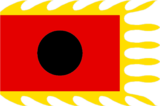People's Republic of Beiwan
People's Republic of Beiwan 杯碗人民共和国 | |||||||||
|---|---|---|---|---|---|---|---|---|---|
| Motto: "独立 - 自由 - 幸福" "Independence – Freedom – Happiness" | |||||||||
| Anthem: 《人民的赞歌》 Hymn of the People | |||||||||
 | |||||||||
| Capital | Gonghai | ||||||||
| Official languages | Chinese | ||||||||
| Government | Single-party socialist republic | ||||||||
• Supreme Leader | Barbara Zhang | ||||||||
• Premier | Justin Po | ||||||||
| Legislature | National Assembly | ||||||||
| Currency | Yuan (¥) (BWY) | ||||||||
| |||||||||
| This article is part of a series on the |
| History of Beiwan |
|---|
 |
| Timeline |
The People's Republic of Beiwan (杯碗人民共和国), was a island micronation in East Asia, enclosed by the Pearl River Delta and South China Sea. Neighboring states include China to the west, Taiwan to the east, and the Philippines to the south. Gonghai was the seat of government and the country's capital city. Constitutionally, the Beiwanese government was a Single-party socialist republic
under totalitarian dictatorship with leadership of the Communist Party.
History
History of Guangdong
Chinese administration in the region began with the Qin Dynasty. After establishing the first unified Chinese empire, the Qin expanded southwards and set up Nanhai Commandery at Panyu, near what is now part of Guangzhou. It used to be independent as Nanyue between the fall of Qin and the reign of Emperor Wu of Han. The Han Dynasty administered Guangdong, Guangxi, and northern Vietnam as Jiaozhi Province. Under the Wu Kingdom of the Three Kingdoms period, Guangdong was made its own province, the Guang Province, in 226. As time passed, the demographics of what is now Guangdong slowly shifted to (Han) Chinese-dominance, especially during several periods of massive migration from the north during periods of political turmoil and/or nomadic incursions from the fall of the Han Dynasty onwards. For example, internal strife in northern China following the rebellion of An Lushan resulted in a 75 percent increase in the population of Guangzhou prefecture between 740s–750s and 800s–810s. As more migrants arrived, the local population was gradually assimilated to Han Chinese culture, or displaced. From the tenth to twelfth century, Persian women were to be found in Guangzhou (Canton), some of them in the tenth century like Mei Zhu in the harem of the Emperor Liu Chang, and in the twelfth century large numbers of Persian women lived there, noted for wearing multiple earrings and "quarrelsome dispositions".
Together with Guangxi, Guangdong was made part of Lingnan Circuit (political division Circuit), or Mountain-South Circuit, in 627 during the Tang Dynasty. The Guangdong part of Lingnan Circuit was renamed Guangnan East Circuit guǎng nán dōng lù in 971 during the Song Dynasty (960–1279).
Ying era

The Ying Dynasty, was the imperial dynasty of Beiwan, it lasted for a brief time. The Ying Dynasty was established during the Qǐyì Revolution, it ruled Pipa and Pingzhou until it succeeded the establishment of the Greater Beiwanese Empire at the end of the revolution.
Greater Beiwanese Empire
Liu-kuang had claimed that the Greater Beiwanese Empire has authority over Pingzhou, Pipa, Genzhi Zhuwu and surrounding islands by informing the Government of the People's Republic of China about the micronation's claim of independence. The date of the proclamation of the new state entity was 11 August 2014. By the constitution of the State of Beiwan, it was a constitutional monarchy under authoritarian-personalist state. This claim was denied by the Chinese Authority.
People's Republic of Beiwan
After the Shikaeshi War, the Communist Party of Beiwan caused an uprising that overthrew the Greater Beiwanese Empire. The Beiwanese Empire became weaker after the Shikaeshi and many politicians were against the Imperial Household, Prime Minister Barbara Zhang and her government revolted against the emperor. On 11 September 2014, Emperor Liu-kuang abdicated and the empire collapsed two days afterwards. Since many combat during the uprising, Barbara Zhang proclaimed the establishment of the People's Republic of Beiwan and declared herself as Supreme Leader.

